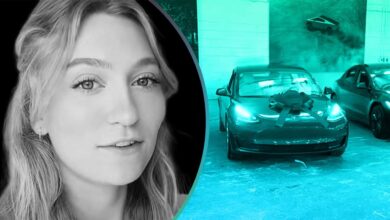Amazon’s Zoox Robotaxis Are Coming. Are We Ready?

- Amazon subsidiary Zoox could be Waymo’s biggest rival as it opens its first dedicated robotaxi factory in the U.S.
- Unlike Waymo and Tesla, the Zoox pods are purpose-built vehicles with no steering wheels and pedals.
- Zoox claims advantages from its vertical integration. It will build, own and operate its robotaxi fleet all by itself.
Amazon’s autonomous vehicle subsidiary Zoox opened its first production facility in the U.S. in Hayward, California, the company announced on Wednesday. The 220,000 square feet manufacturing site is equivalent to 3.5 football fields and aims to build 10,000 robotaxis annually when running at maximum capacity.
Another number that’s significant for Zoox: zero steering wheels, zero pedals.
Automakers and tech giants are betting big on driverless taxis, claiming that they can make getting around cheaper and safer. But the stakes are extremely high. Apart from Alphabet’s Waymo, no one has really proved that robotaxis will be actually safe and scalable. But a growing number of companies are rushing to deploy robotaxis anyway to gain an early market advantage.
That includes Zoox, which is about to deploy a true driverless taxi at scale—not a retrofitted car with redundant controls like Waymo’s Jaguar fleet.

7
Source: Zoox
The Zoox robotaxis are purpose-built vehicles, designed from the ground-up to ferry passengers autonomously, with no steering wheels or pedals. The toaster-shaped pods have wheels on extreme corners and their doors slide open like the NYC subway. Inside, the setting is far more communal than a Waymo or a Tesla, with flat bench seats where passengers face each other, like sitting in a small living room.
The new California production facility will not just have vehicle assembly, but also robotaxi engineering, software and hardware integration and end-of-line testing, where the vehicles undergo final quality checks. Each unit is also tested on an outdoor test track to verify whether it’s behaving as intended and if the build quality is up to standards, the company claims.
Zoox is also aiming to be highly vertically integrated, as it plans to own, assemble and operate the fleet all by itself, which will allegedly allow the production to be flexible.
The company’s approach to autonomy is similar to that of Waymo. Its pods use a full suite of sensors including lidar, radar, and cameras to make sense of the environment around and then actively execute driving decisions without human input based on what it “sees.” Tesla, by contrast, is betting on a camera-only system powered by artificial intelligence, arguing that expensive hardware like lidar hampers scalability.

Photo by: Zoox
However, experts say it could take years for the robotaxi companies to showcase any statistically significant safety record. Federal data suggests humans can already drive nearly 100 million miles before a fatal crash occurs.
Most operators aren’t anywhere close to clocking that sort of mileage yet—although Waymo is getting close with 71 million rider-only miles clocked as of March 2025. Plus, scientists say racking up miles in the safest parts of Austin in sunny weather isn’t exactly what constitutes a safe robotaxi—Tesla is planning to launch its robotaxi there as soon as next week.
Billions of miles in diverse terrain, different regions and varied driving conditions are required to generate significant enough data to evaluate safety, according to top AI scientists.
That said, we do have first ride impressions from a Zoox robotaxi around Las Vegas. Check that out to learn what the Amazon-owned company has in store for the future.
Contact the author: suvrat.kothari@insideevs.com
Source link

